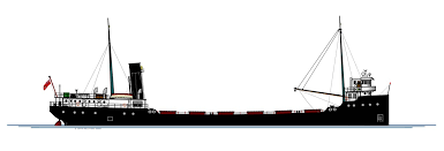Jinx Ship Maine
By James Donahue
When fire claimed the steamship Maine on the St. Clair River the night of July 16, 1911, it spelled the end of one of the most unlucky boats ever to traverse the Great Lakes. Sailors may have called it a jinx, or hoodoo ship because of the disasters that plagued its forty-nine-year career. Despite numerous fires, a sinking and one boiler explosion, the Maine continued to rise up like a phoenix from the ashes to sail again until the final fire at Marine City, Michigan.
The Maine was not a large vessel, although it was originally designed for both passenger and freight service. When launched at Cleveland in 1862, it measured a modest one hundred thirty-five feet and had a gross displacement of slightly more than four hundred tons.
The first sign of bad luck happened July 5, 1871, as the Maine approached Ogdensburg, New York, on the St. Lawrence River, at the end of a long trip through the lakes from Chicago. The steamer was but a mile from Ogdensburg when the boiler exploded, killing six people and wounding two. The following summer the Maine struck a rock in the Welland Canal and sank in shallow water at Goose Bay, Lake Ontario. It was raised ten days later and returned to service.
The fires started on May 22, 1880, while the Maine was docked at Port Huron. Fire broke out in a cargo of jute in the boat’s hold at 2:15 AM while it was moored at the Northern Transit Company wharf. The blaze soon forced the crew to flee. The burning vessel was cast adrift on the St. Clair River to protect the dock and nearby warehouses. The propeller Milwaukee, docked nearby, also cast off and steamed out into the river to escape the flames. The Maine drifted until it went aground on the Canadian side of the river and sank. But that was not the end of the little steamer. The hull was raised a month later and the Maine was rebuilt as a lumber carrier.
The boat burned a second time on April 15, 1898, while fitting out at Tonawanda, New York. It was raised again and the scorched hull towed to Bay City, Michigan, where the vessel was rebuilt and returned to service yet again in October, 1899.
Incredibly the old boat remained on the lakes for another eleven years before a third fire finished it off in 1911. The Maine, this time under the command of Capt. William Booth, was steaming up the St. Clair River with a cargo of coal when flames were discovered in the hold. The fire spread so fast through the boat’s dry old wooden decks that all Booth could do was drive his boat aground on the Canadian side of the river. The crew jumped ashore, not taking time to collect any personal belongings. This time the Maine was not recovered.
By James Donahue
When fire claimed the steamship Maine on the St. Clair River the night of July 16, 1911, it spelled the end of one of the most unlucky boats ever to traverse the Great Lakes. Sailors may have called it a jinx, or hoodoo ship because of the disasters that plagued its forty-nine-year career. Despite numerous fires, a sinking and one boiler explosion, the Maine continued to rise up like a phoenix from the ashes to sail again until the final fire at Marine City, Michigan.
The Maine was not a large vessel, although it was originally designed for both passenger and freight service. When launched at Cleveland in 1862, it measured a modest one hundred thirty-five feet and had a gross displacement of slightly more than four hundred tons.
The first sign of bad luck happened July 5, 1871, as the Maine approached Ogdensburg, New York, on the St. Lawrence River, at the end of a long trip through the lakes from Chicago. The steamer was but a mile from Ogdensburg when the boiler exploded, killing six people and wounding two. The following summer the Maine struck a rock in the Welland Canal and sank in shallow water at Goose Bay, Lake Ontario. It was raised ten days later and returned to service.
The fires started on May 22, 1880, while the Maine was docked at Port Huron. Fire broke out in a cargo of jute in the boat’s hold at 2:15 AM while it was moored at the Northern Transit Company wharf. The blaze soon forced the crew to flee. The burning vessel was cast adrift on the St. Clair River to protect the dock and nearby warehouses. The propeller Milwaukee, docked nearby, also cast off and steamed out into the river to escape the flames. The Maine drifted until it went aground on the Canadian side of the river and sank. But that was not the end of the little steamer. The hull was raised a month later and the Maine was rebuilt as a lumber carrier.
The boat burned a second time on April 15, 1898, while fitting out at Tonawanda, New York. It was raised again and the scorched hull towed to Bay City, Michigan, where the vessel was rebuilt and returned to service yet again in October, 1899.
Incredibly the old boat remained on the lakes for another eleven years before a third fire finished it off in 1911. The Maine, this time under the command of Capt. William Booth, was steaming up the St. Clair River with a cargo of coal when flames were discovered in the hold. The fire spread so fast through the boat’s dry old wooden decks that all Booth could do was drive his boat aground on the Canadian side of the river. The crew jumped ashore, not taking time to collect any personal belongings. This time the Maine was not recovered.
